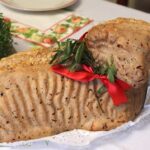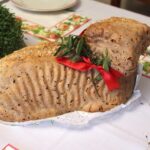
Easter in Germany wouldn’t be complete without a slice of Osterzopf, the traditional German Easter braided bread. With its rich, buttery dough, lightly sweetened taste, and golden, glossy crust, Osterzopf is a staple on Easter breakfast and brunch tables. This soft and fluffy yeast bread, often sprinkled with almonds and pearl sugar, has been a cherished tradition for generations. The braided shape symbolizes unity and celebration, making it a perfect centerpiece for festive gatherings. In this article, we’ll explore the history of Osterzopf, its significance in German culture, and provide a step-by-step guide so you can bake this delicious Easter bread at home.
History & Cultural Significance
The Origins of Osterzopf
The tradition of braided breads in Germany dates back to medieval times, when sweet yeasted loaves were prepared for religious feasts and celebrations. The Osterzopf, which translates to “Easter braid,” has been associated with springtime renewal and Easter festivities for centuries.
In many German households, Osterzopf is baked on Easter Sunday morning and served with butter, jam, or honey. The braid itself is symbolic, representing unity, faith, and family ties. Some families also bake Osterkranz, a wreath-shaped variation of Osterzopf, often decorated with dyed Easter eggs.
This traditional bread remains popular across Germany, with slight variations in Bavaria, Swabia, and Austria—where some recipes include raisins, nuts, or citrus zest for extra flavor.
Want to explore more German Easter recipes? Check out our articles on German Easter Traditions and Authentic German Breads.
Ingredients & Preparation (Step-by-Step Recipe Guide)
Ingredients for Authentic Osterzopf
Dough Ingredients:
- 500g (4 cups) all-purpose flour
- 75g (⅓ cup) sugar
- 1 packet (7g) dry yeast or 25g fresh yeast
- 250ml (1 cup) warm milk
- 80g (⅓ cup) unsalted butter, softened
- 1 egg
- 1 tsp salt
- ½ tsp vanilla extract (optional)
For Brushing & Topping:
- 1 egg yolk, beaten (for glazing)
- 2 tbsp milk
- 2 tbsp sliced almonds or pearl sugar
Substitutes: If you don’t have fresh yeast, use dry yeast (7g = one packet). If you prefer a richer flavor, add a pinch of cardamom or lemon zest.
How to Make Osterzopf (Step-by-Step Instructions)
Step 1: Activate the Yeast
- Warm the milk slightly (not too hot).
- Stir in sugar and yeast, let it sit for 5-10 minutes until frothy.
Step 2: Prepare the Dough
- In a large mixing bowl, combine flour and salt.
- Add the yeast mixture, butter, egg, and vanilla extract.
- Knead the dough for 10 minutes until smooth and elastic.
Pro Tip: If the dough is sticky, sprinkle in a bit more flour. If it’s dry, add a spoonful of warm milk.
Step 3: Let the Dough Rise
- Cover the dough with a clean towel and let it rise in a warm place for 60-90 minutes until doubled in size.
Step 4: Shape & Braid the Osterzopf
- Divide the dough into three equal pieces and roll them into long strands.
- Braid the strands together and tuck the ends underneath.
- Place the braid on a baking sheet lined with parchment paper.
Step 5: Final Rise & Baking
- Cover and let the dough rise again for 30 minutes.
- Preheat oven to 180°C (350°F).
- Brush the braid with egg yolk mixed with milk and sprinkle with almonds or sugar.
- Bake for 25-30 minutes, or until golden brown.
Serving Suggestions & Variations
How to Serve Osterzopf
Osterzopf is best served fresh and slightly warm with:
- Butter and honey for a traditional German breakfast
- Homemade jam or Nutella for a sweeter option
- Soft cheese or quark for a creamy contrast
Variations & Regional Twists
In Bavaria, Osterzopf is often made with raisins and a touch of rum. In Swabia, it is sometimes shaped into an Easter wreath (Osterkranz) with dyed eggs in the middle. In Austria, a hint of cardamom or lemon zest is added for extra aroma.
Want to try another Easter treat? Check out our Osterlamm (Easter Lamb Cake) recipe.
Baking Osterzopf at home is a rewarding tradition that brings warmth and joy to any Easter celebration. Its soft, fluffy texture and subtly sweet flavor make it a favorite in German households. Whether you enjoy it plain, with butter, or as part of a festive Easter brunch, this braided bread is sure to impress.
Looking for more traditional German Easter recipes? Explore our recipes for Hefezopf, Brandenburg Lamb, and Franzbrötchen.







